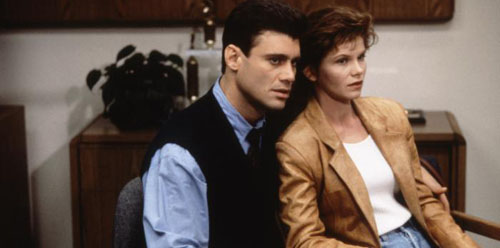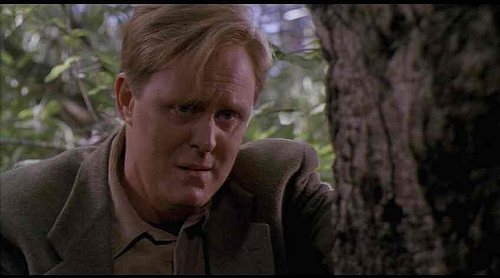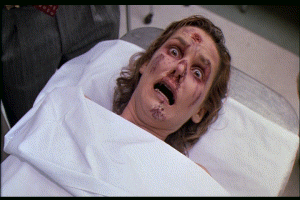BAUER TALKS 'SCARFACE' & 'RAISING CAIN'
AND HIS CAMEO IN 'BODY DOUBLE' Starpulse's Jason Coleman
Starpulse's Jason Coleman sat down with
Steven Bauer for a career-spanning interview, timed to the release of
Scarface on Blu-Ray this week. Bauer talked about
Brian De Palma's directing style,
Oliver Stone's shocked reaction to being told that one of the scenes he had written for
Scarface was not going to be filmed, and how De Palma restrained him for his role as Jack in
Raising Cain. Here are some excerpts:
[Coleman] I’ve always wanted to know what De Palma is like as a director and specifically his filmmaking process when it come to working with the actors? SB: Well, he was very, very hands off – he’s actually very trusting of the actors. He chooses great actors and let’s them do their thing. The most I ever saw him do was with Michelle. For us, he never said anything to us except ‘where are you walking in’ or ‘where do you want to do this’, you know? He let us play the scene and then he would move the camera. But with Michelle because she was so new, she was intimidated and it worked for the character and he kept her off balance I think. He wasn’t very nurturing and encouraging with her. She was having her issues of being the girl, the only girl, and us being in our own world and it worked for her. She explodes and she’s so angry and so done with Tony being such an ass and it was all about the boys. And that worked for her – she walked around like that. Really fragile and Brian didn't do anything to help that.
[Coleman] If screenplay writer Oliver Stone was on set a lot, were there any interesting discussions that came up between the two of you during shooting?
SB: Oliver was NOT on the set a lot – another news bulletin! Oliver was basically banned from the set after the second or third week out of seventeen weeks we shot. He was banned and the reason is because he had a lot to say about the scenes that he wrote and how they were played and what was said and everything. And once we started shooting it was like Oliver, please! Because he’d come around and he’d say, ‘What are you doing? What are you shooting today? What’s going on? What are you gonna do?’ And Brian would say, ‘Can you just relax and please let us do what we’re doing?’
[Coleman] Do you feel like it was that director side of Oliver coming to the surface?
SB: Absolutely! He was ready to go! He was ready to make his own movie! He couldn't help it! Put him on the set and he’s gonna tell you how to shoot the scene! It was just not a happy union - there was not a collaboration there at all. The collaboration was that he delivered this beautiful screenplay and we went to work with it. But his offerings were not welcome and eventually he was told in no uncertain terms that he was not welcome. And I think it really bugged the shit out of him – he was not a happy camper. One day he was standing outside the gates at Universal and I was pulling up and he called me over and he goes, ‘Hey, Steven! Steven!’ And I go, ‘What are you doing there?’ And he goes, ‘Well, they won’t let me on the set!’ So I said, ‘What?!’ And he goes, ‘Can you just tell me what your shooting today?’ (Laughs) And I remember this one moment – I can't tell you specifically, but the script was bigger then what we shot obviously and there were scenes we had to cut because they were to expensive. And I remember one day he found me and he goes, ‘Have you done the scene with the so and so...” and I said, ‘Uhhh...no, we’re not doing that scene.’ And he was like, ‘What do you mean you’re not doing that scene?’ And I’m like, ‘They cut it.’ And he goes, ‘Are you KIDDING me?!’ – like crazy! That’s another interesting thing that most people don't know.
'RAISING CAIN'
[Coleman] "Raising Cain" was you second acting collaboration with De Palma – can you tell me what was both similar and different from working with him when you did "Scarface" vs. "Raising Cain?"
SB: "Raising Cain" is much more his comfort zone I think. "Scarface" was a tremendous undertaking and I’m one of those who really feel that no one could have done it like Brian De Palma. In that case I’m a Brian De Palma supporter and the way the film was made, the way the film is directed, "Scarface" is brilliant. The rhythm, tone and editing of it is perfect and a lot of that is him. Now that being said, I was sort of a skeptic before I met him and worked with him because the films that he made before "Scarface" always left me really frustrated. I was impressed by his technical and cinematic style, but I also felt manipulated always and I don't like feeling that as an audience member. I don't like feeling the director manipulating. So I wasn’t a big fan let’s just say, but when you get to "Raising Cain" after "Scarface," I’m a big fan. One more time he had me – I loved what he did with that movie. Loved the way it’s done, love the way it works on the senses and the surprises and I loved the acting in it. John Lithgow is amazing – he’s just so weird and goofy and beautiful. And he directed me really well too and he got a performance out of me I didn’t expect to deliver. I really thought of myself as much more active and he kept me really restrained, even in my physical appearance. I had to do everything possible to not fight him on it because it was like he wanted my hair combed all the time, he wanted the overcoat and he wanted me in a 3-piece suit. I said, ‘Why a 3-piece – why do I have to wear a vest?’ He goes, ‘Because I want you to be absolutely beautiful and gorgeous and I want you to be absolutely groomed perfectly in every scene – that’s who you are!’ (Laughs) He has these precepts and concepts on film visually that he imposes on the story and he’ll make it work, or not! In that movie it really works.
Bauer was also asked about his cameo in De Palma's Body Double ("It was just a cameo role that Brian put me in as a joke"), which he describes with just a bit of misremembrance (his cameo is actually during the "Holly Does Hollywood" commercial, not during the Frankie Goes To Hollywood segment), and several of his other films, including Steven Soderbergh's Traffic.






 Thanks to
Thanks to 
